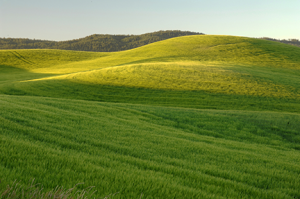
But making those maps will take more than satellite data. It will require special software, and that’s where James Tilton, a computer engineer at NASA’s Goddard Space Flight Center in Greenbelt, Md., can help.
Tilton will apply and build on a software program he developed for another NASA project to help NASA’s Making Earth System data records for Use in Research Environments program, or MEaSUREs, map 3.7-billion acres of cropland worldwide.
“The idea of this project is to have an accurate cropland data set,” said Prasad Thenkabail, the principal investigator of the MEaSUREs project and a research geographer with the U.S. Geological Survey in Flagstaff, Ariz. “Ultimately, it will help provide a better accounting of water use, cropland productivity, and water productivity — all critical information for studying global food security.”
The first step in this five-year project is locating and mapping the fields. However, that can be a challenge in countries that have little, if any, data on what farmers grow, or in countries that refuse to provide accurate information on what is growing where. “The satellite platforms offer an opportunity to look at the entire world in a unique way,” Thenkabail said. “It has no bias.”
However, satellite data are made up of ones and zeros, and will have to be sorted to ultimately create the cropland maps. Tilton believes his software program, which identifies urban areas in Landsat’s 30-meter/32.8-yard, lower-resolution remote-sensing imagery, will help zero in on cropland, as well.
With satellite images at higher resolution, he has developed a program that identifies homogenous regions — areas like lakes, a block of buildings, or a field.
“The software itself doesn’t have any idea what it is,” Tilton said. “It’s just something that’s similar in the spectrum.”
This initial step identifies the ground-cover types of interest, using the high-resolution images from representative areas across the globe. Researchers use this to train a computer program, applying it to medium-resolution satellite images that cover a larger swath of ground—such as the 30-meter/32.8-yard Landsat images. At that resolution, the program will scan the globe, looking for specific wavelengths indicating cities, cropland, or other features.
“I anticipate that a lot of what’s developed for urban areas will be applicable, maybe with some minor modifications, to the new global croplands project,” Tilton said.
One cropland-identification tool he’s working on searches for edges or boundaries between different land-use areas that reflect different wavelength patterns. These could indicate agricultural field boundaries. In this program, the software would ignore gradual, subtle changes in neighboring pixels to look for more dramatic changes, resulting in a jigsaw-puzzle-like map of a region.
“If farmers have distinct fields, this should really help,” Tilton said. But because agricultural practices differ around the globe, he knows challenges will arise. “For different areas, we’ll change what we’re doing … That’ll be the experimental part.”
Related Links:
+ MEaSUREs program
+ NASA Goddard technology news

Scenes from the Polar Night
Landsat satellites have begun regularly acquiring images of ice at the poles during the winter, with enlightening results.





